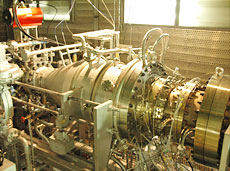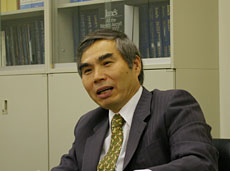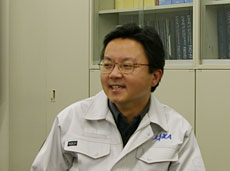
Q. What are the challenges in developing clean engine technology?
Yamane: We develop ideas for new technologies, but the challenge after that is the production of test models, which we outsource. It can be very difficult to have things made precisely to our specifications, especially when a new technique or technology is required. Turbine blades are especially difficult - their internal structure is complicated, with various shapes of projections to cool the blade from inside. If we want to increase the turbine's performance, the structure inevitably has to become more complicated. And when we attempt unconventional designs, it is difficult to get our intention across to the manufacturers. Even if the finished model initially appears to be exactly what we asked for, it sometimes turns out that it functions totally differently. So we really have to be cautious.

Full Annular Combustor Test Facility
Makida: In my case, I'm responsible for a new combustor, and on our team, the development and facility operation staff work together. So, for example, when we want to develop a specific combustor, the designers are also involved in testing the operation of the facilities. I think that if designers do not get to see the actual test facility in person, important details can easily be overlooked. I find that private companies, our research partners, often have separate divisions for research and facility operations. Some companies have even introduced a system where the engineers who are doing the R&D are allowed to go to the test site only to write specifications, asking the facilities staff to change the airflow and the fuel flow here and there, for example. This system can sometimes be more efficient, but there is no way to know whether the testing staff are reporting all the pieces of information the designers need. When we conduct a test together, if, for example, the value of measured temperature is not what I expected, I can stop the test and suggest that we start over. But if we are only giving written specifications, we cannot react as quickly. In this respect, to make progress in development, it is very important to work closely with private-sector staff who have different systems from us.


Hayashi: At this stage, each section is working on different key engine technologies, but eventually they all have to be put together. Even if we build a combustor with lower nitrogen oxides (NOx) emissions, it will be useless if it functions for only an hour, or negatively affects turbines and the other aspects of the engine. To build a quieter engine with lower NOx and CO2 emissions, we need to advance development very efficiently, by communicating well with other sections, and also by dividing up responsibilities between us and our private-sector research partners. But to work at maximum efficiency, we need more staff. At the end of the day, the essence of technological development is people. I've been developing combustors for a long time, but I have taken care of a series of operations almost entirely by myself - designing, testing outsourced work, collecting and analyzing data, and planning the next tests. It gives me a great view of the overall picture, so it is interesting for sure. But the fact is, what I can do alone is limited. If these tasks were divided among several people, everyone's knowledge and experience would contribute to finding better methodologies. Also, each of us would be able to spend more time thinking about the design, which, in the end, would lead to better results.
Q. What led you to become involved in aviation technology research?
 Makida: I wasn't particularly into airplanes when I was a child, but I always loved making things. That passion for making things that no one has made before hasn't changed. So in a sense, the opportunity to develop combustors in this laboratory has been a dream come true.
Makida: I wasn't particularly into airplanes when I was a child, but I always loved making things. That passion for making things that no one has made before hasn't changed. So in a sense, the opportunity to develop combustors in this laboratory has been a dream come true.
Yamane: I was a big fan of the spaceship Arcadia in Leiji Matsumoto's science fiction manga Space Pirate Captain Herlock. I was fascinated with vessels that flew very fast in space. But since the chances of building such a spaceship were slim, I studied jet engines in university, and my preference shifted to really fast jet aircraft.
Hayashi: I was originally interested in designing airframes for an aircraft manufacturer. But unfortunately, Japan's aviation industry has fallen behind since development was stopped after Japan lost World War II. So I thought that the only way to catch up and attain supremacy in the world was to develop a new environmental technology. In the field of aviation, if environmental regulations continue to tighten, I think that a nation that has established effective environmental technology will do very well. Japan has never made all its engine components using exclusively its own technology. So I'm very keen to develop new technology for clean engines on our own.
Q. What is your goal or dream now?
Makida: I'd like to contribute to, for example, NEDO's ECO Engine project, with the clean engine technology we are developing. I hope that, in the future, the technology I had a hand in developing will spread to other applications beyond just eco engines. And I'm really looking forward to watching my engine flying through the sky.


Yamane: My dream is that my research work will be mass-produced for civil aircraft that I will be able to fly in. Until now, turbine technology, which is my domain, has been the preserve of foreign companies. Unless Japan initiates its own engine production, our turbine technology will hardly have a chance to see the light of day. So, first of all, I'd like to build an engine with our clean engine technology. Once it's in use, there will be more innovation, with new variations. If Japan becomes capable of building an engine entirely on its own, this will also enable us to take charge in the modification of our own engine technology.
Hayashi: My dream is also to fly on an aircraft with an engine made with our technology. I'm looking forward to the implementation of Japanese-made, environmentally friendly engines.
Yamane: We develop ideas for new technologies, but the challenge after that is the production of test models, which we outsource. It can be very difficult to have things made precisely to our specifications, especially when a new technique or technology is required. Turbine blades are especially difficult - their internal structure is complicated, with various shapes of projections to cool the blade from inside. If we want to increase the turbine's performance, the structure inevitably has to become more complicated. And when we attempt unconventional designs, it is difficult to get our intention across to the manufacturers. Even if the finished model initially appears to be exactly what we asked for, it sometimes turns out that it functions totally differently. So we really have to be cautious.

Full Annular Combustor Test Facility

Hayashi: At this stage, each section is working on different key engine technologies, but eventually they all have to be put together. Even if we build a combustor with lower nitrogen oxides (NOx) emissions, it will be useless if it functions for only an hour, or negatively affects turbines and the other aspects of the engine. To build a quieter engine with lower NOx and CO2 emissions, we need to advance development very efficiently, by communicating well with other sections, and also by dividing up responsibilities between us and our private-sector research partners. But to work at maximum efficiency, we need more staff. At the end of the day, the essence of technological development is people. I've been developing combustors for a long time, but I have taken care of a series of operations almost entirely by myself - designing, testing outsourced work, collecting and analyzing data, and planning the next tests. It gives me a great view of the overall picture, so it is interesting for sure. But the fact is, what I can do alone is limited. If these tasks were divided among several people, everyone's knowledge and experience would contribute to finding better methodologies. Also, each of us would be able to spend more time thinking about the design, which, in the end, would lead to better results.
Q. What led you to become involved in aviation technology research?

Yamane: I was a big fan of the spaceship Arcadia in Leiji Matsumoto's science fiction manga Space Pirate Captain Herlock. I was fascinated with vessels that flew very fast in space. But since the chances of building such a spaceship were slim, I studied jet engines in university, and my preference shifted to really fast jet aircraft.
Hayashi: I was originally interested in designing airframes for an aircraft manufacturer. But unfortunately, Japan's aviation industry has fallen behind since development was stopped after Japan lost World War II. So I thought that the only way to catch up and attain supremacy in the world was to develop a new environmental technology. In the field of aviation, if environmental regulations continue to tighten, I think that a nation that has established effective environmental technology will do very well. Japan has never made all its engine components using exclusively its own technology. So I'm very keen to develop new technology for clean engines on our own.
Q. What is your goal or dream now?
Makida: I'd like to contribute to, for example, NEDO's ECO Engine project, with the clean engine technology we are developing. I hope that, in the future, the technology I had a hand in developing will spread to other applications beyond just eco engines. And I'm really looking forward to watching my engine flying through the sky.

Yamane: My dream is that my research work will be mass-produced for civil aircraft that I will be able to fly in. Until now, turbine technology, which is my domain, has been the preserve of foreign companies. Unless Japan initiates its own engine production, our turbine technology will hardly have a chance to see the light of day. So, first of all, I'd like to build an engine with our clean engine technology. Once it's in use, there will be more innovation, with new variations. If Japan becomes capable of building an engine entirely on its own, this will also enable us to take charge in the modification of our own engine technology.
Hayashi: My dream is also to fly on an aircraft with an engine made with our technology. I'm looking forward to the implementation of Japanese-made, environmentally friendly engines.
Dr. Shigeru Hayashi
Manager, Clean Engine Team, Aviation Program Group, JAXA
Dr. Hayashi's research focus is on low-NOx combustion technology for aircraft and industrial gas turbines. Since he joined the National Aerospace Laboratory of Japan (now part of JAXA), he has served as the NOx reduction innovation research group leader, and director of the Aircraft Propulsion Research Center. Dr. Hayashi was appointed to his current position in 2005. He is also director of the Clean Engine Technology Development Project.
Mitsumasa Makida
Associate Senior Researcher, Low-Emissions Technology Section, Clean Engine Team, Aviation Program Group, JAXA
Mr. Makida received a B.Sc. in 1992, and a M.Sc. in 1994 from the Department of Aerospace Engineering at Nagoya University. After that, he joined the National Aerospace Laboratory of Japan (now part of JAXA) and researched numerical analysis for combustors. Subsequently, he was engaged in the management of the engine development project at the Agency of Industrial Science and Technology at the Ministry of International Trade and Industry, research at Cranfield University in the United Kingdom, and project risk management at JAXA's strategic planning department. He has been in his current position since 2004. His focus is on the development of aircraft combustors.
Dr. Takashi Yamane
Associate Senior Researcher, High Temperature Section, Clean Engine Team, Aviation Program Group, JAXA
Dr. Yamane received a B.Sc. in 1987 from the Department of Aeronautics and Astronautics at the University of Tokyo, and a Ph. D. in 1992 from the Department of Aeronautics and Astronautics, School of Engineering at the University of Tokyo. The same year, he joined the National Aerospace Laboratory of Japan (now part of JAXA), and was engaged in CFD analysis and thermal analysis of the flow in jet engines. Meanwhile he also worked at the Agency of Industrial Science and Technology at the Ministry of International Trade and Industry, managing engine development projects. Dr. Yamane was appointed to his current position in 2006, and has since been responsible for the development of thermal resistance/cooling systems for jet engine turbine components.
Manager, Clean Engine Team, Aviation Program Group, JAXA
Dr. Hayashi's research focus is on low-NOx combustion technology for aircraft and industrial gas turbines. Since he joined the National Aerospace Laboratory of Japan (now part of JAXA), he has served as the NOx reduction innovation research group leader, and director of the Aircraft Propulsion Research Center. Dr. Hayashi was appointed to his current position in 2005. He is also director of the Clean Engine Technology Development Project.
Mitsumasa Makida
Associate Senior Researcher, Low-Emissions Technology Section, Clean Engine Team, Aviation Program Group, JAXA
Mr. Makida received a B.Sc. in 1992, and a M.Sc. in 1994 from the Department of Aerospace Engineering at Nagoya University. After that, he joined the National Aerospace Laboratory of Japan (now part of JAXA) and researched numerical analysis for combustors. Subsequently, he was engaged in the management of the engine development project at the Agency of Industrial Science and Technology at the Ministry of International Trade and Industry, research at Cranfield University in the United Kingdom, and project risk management at JAXA's strategic planning department. He has been in his current position since 2004. His focus is on the development of aircraft combustors.
Dr. Takashi Yamane
Associate Senior Researcher, High Temperature Section, Clean Engine Team, Aviation Program Group, JAXA
Dr. Yamane received a B.Sc. in 1987 from the Department of Aeronautics and Astronautics at the University of Tokyo, and a Ph. D. in 1992 from the Department of Aeronautics and Astronautics, School of Engineering at the University of Tokyo. The same year, he joined the National Aerospace Laboratory of Japan (now part of JAXA), and was engaged in CFD analysis and thermal analysis of the flow in jet engines. Meanwhile he also worked at the Agency of Industrial Science and Technology at the Ministry of International Trade and Industry, managing engine development projects. Dr. Yamane was appointed to his current position in 2006, and has since been responsible for the development of thermal resistance/cooling systems for jet engine turbine components.
Leading Japan's Aviation Industry
JAXA's Initiative for the Development of Clean Engine Technologies in Japan
For Fulfillment of Quiet Supersonic Passenger Aircraft
JAXA's Initiative for the Development of Clean Engine Technologies in Japan
For Fulfillment of Quiet Supersonic Passenger Aircraft